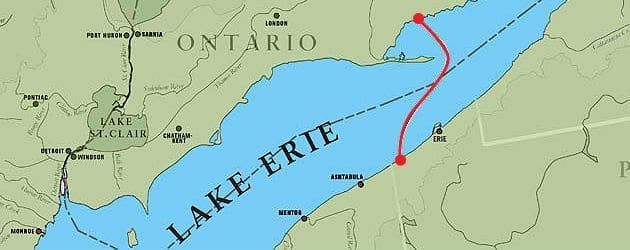Lake Erie Clean Power Connector Project

Location: Lake Erie from Nanticoke, Ontario to Erie County, Pennsylvania
Owner/Operator: ITC Holdings Corp
Engineers: HDR Inc
The privately-funded Lake Erie Clean Power Connector Project, when up and running by late 2020, will deliver Canadian-generated electricity to the grid that supplies power to 60 million Americans in a dozen states in the U.S. Northeast. But it could also carry electricity from the United States to Ontario when there is an emergency, an outage, or if there is a shortage in the coming years. It will involve laying a high-capacity cable starting from Nanticoke, Ontario, stretching about 120 kilometres across the lake floor to Erie County, Pennsylvania. The 1,000-megawatt Lake Erie line will include two transmission cables and a fibre optic communications line, and cost about $1-billion (U.S.) to build.
Unlike most transmission lines that use alternating current, the proposed project will use high-voltage direct current, which works better in long underwater applications, can work in either direction and has less energy loss than AC. HGC was retained by HDR on behalf of U.S.-based transmission company ITC Holdings Corp, to prepare an Acoustic Assessment of the proposed Project. We developed a predictive acoustic model of the Converter Station on the Ontario side using manufacturer’s data of stationary sound sources of the future facility. The Assessment was prepared in support of environmental approvals from the National Energy Board (“NEB”).
The NEB does not have explicit environmental noise guidelines, but typically adopts the guidelines or limits of the Province in which the facility is located which in this case meant following MOE criteria. The Assessment also considered the guidance offered by Health Canada, for environmental noise assessment, given the NEB Election Certificate process being followed for the project. Health Canada does not issue explicit sound level limits, but offers guidance on noise assessment in their publication, “Useful Information for Environmental Assessments”. That document suggests that the probable percent of highly annoyed people be calculated for two cases – the ambient background sound and the combined future sound of the background and the facility
Health Canada suggests that the difference in percentage between the ambient case and the case with the facility under assessment should be limited to an increase of no more than 6.5%. In general, when reviewing Federal Environmental Assessments, Health Canada employs this suggested noise evaluation method.
We also conducted an assessment of The Erie West Converter Station on the American side, based on Alberta Energy Regulator (“AER”) noise guidelines. Unlike the Ontario guidelines which apply to the facility alone, the AER sound level limits apply to the Comprehensive Sound Level (“CSL”), defined to include the sound of the facility and the background sound combined. Also, unlike the Ontario guidelines, AER Directive 38 does not stipulate a penalty for tonal sound character.
Acoustical Engineering Services Included:
- Conducted detailed predictive acoustical assessment in accordance with Ontario Ministry of the Environment and Alberta Energy Regulator procedures, as well as Health Canada guidelines
- Developed predictive acoustic models using manufacturer’s data of stationary sound sources of the future Canadian and US facilities

